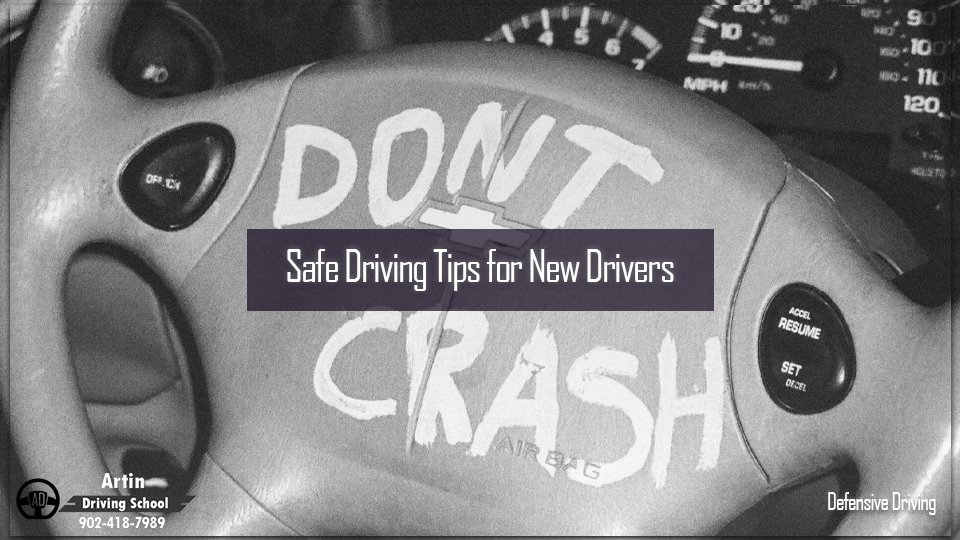Safe Driving Tips for New Drivers
Just got your license? That’s a major milestone — but it’s only the beginning. Real driving experience comes from time on the road, and staying safe means more than remembering rules from your road test. These safe driving tips for new drivers are here to help you avoid common mistakes and build confidence every time you hit the road.
Whether you’re navigating city traffic in Halifax or heading out on rural roads around Nova Scotia, these tips will help you think ahead, stay calm, and make better driving decisions right from the start.
Table of Contents
- Why Safety Matters Most for New Drivers
- Key Habits for Safer Driving
- New Driver Mistakes — and How to Avoid Them
- Driving on Different Road Types
- What to Expect as a New Driver in Nova Scotia
- Want to Learn More?
- Final Word
Why Safety Matters Most for New Drivers
Statistics show that new drivers are more likely to be involved in accidents — not because they’re careless, but because they’re still developing experience. Staying safe isn’t just about knowing the rules — it’s about making the right choices under pressure.
That’s why safe driving habits matter so much. Learning to think ahead, manage stress, and stay alert gives you the tools to avoid danger — and recover calmly if something goes wrong.
Key Habits for Safer Driving
1. Keep Your Eyes Moving
Don’t fixate on the car directly ahead. Scan 12–15 seconds down the road to anticipate stops, lane changes, or hazards. This habit gives you more time to react — and keeps you more in control.
2. Use the Three-Second Rule
Choose a fixed point (like a sign). When the car ahead passes it, count: one-one-thousand, two… If you pass it before three, you’re following too closely. Add extra time in bad weather or poor visibility.
3. Limit Distractions — Even Small Ones
Texting and driving is obviously dangerous, but so is fumbling with your playlist, talking too much with passengers, or zoning out. Set everything before you move. Stay fully focused on the drive.
4. Be Predictable
Signal early. Don’t make sudden turns or lane changes. When other drivers know what you’re doing, they can react safely — and that keeps everyone out of trouble.
5. Adjust for Conditions
If it’s raining, foggy, or snowy, slow down and increase your following distance. Nova Scotia’s weather changes fast — drive for the conditions, not just the speed limit.
6. Stay Calm in Unfamiliar Situations
If you miss a turn, don’t panic. Keep going and find a safe place to pull over or turn around. Stress causes overreactions. Stay cool, breathe, and correct safely.
7. Practice Parking, Merging, and Intersections
The more you practice, the more confident you’ll feel. Spend time in quiet areas working on parallel parking, smooth merges, and turning at lights. These skills matter more than speed or style.
New Driver Mistakes — and How to Avoid Them
Everyone makes mistakes when they’re learning — but knowing what to expect can help you avoid the most common ones:
- Tailgating: Back off and give yourself room.
- Braking too late: Look ahead and slow down early.
- Forgetting blind spots: Always shoulder check before lane changes.
- Overcorrecting: Small steering adjustments are safer than jerking the wheel.
- Speeding to “keep up”: Drive your pace. Let others pass if needed.
Driving on Different Road Types
In the City
Expect more stops, distractions, and pedestrians. Stay alert at intersections, scan sidewalks, and anticipate people stepping off curbs without warning.
On the Highway
Use mirrors regularly, keep a steady speed, and never stop at the end of an on-ramp. Let others merge, and stay right unless you’re passing.
Rural Roads
Look out for wildlife, unmarked turns, and gravel shoulders. Reduce speed before sharp curves and use high beams when appropriate.
What to Expect as a New Driver in Nova Scotia
Nova Scotia offers everything from busy Halifax intersections to quiet Cape Breton backroads — and each type of driving has its challenges:
- Fog and wind: Common in spring and fall. Reduce speed and drive cautiously in low visibility.
- Black ice: Especially early mornings in colder months. Brake gently and don’t oversteer.
- Narrow rural routes: Use your horn on blind curves, drive slowly, and watch for wildlife.
- Pedestrian-heavy zones: Downtowns and school areas require constant attention. Always yield and slow down early.
Want to Learn More?
These safe driving tips for new drivers are just the beginning. If you want real, on-the-road awareness and preparation, our Defensive Driving Course in Halifax covers advanced techniques, traffic psychology, and how to handle real Nova Scotia road conditions.
You can also find practical resources from Transport Canada’s Road Safety Program.
Final Word
Safe driving tips for new drivers aren’t about being perfect — they’re about being ready. The more you anticipate, the fewer surprises you’ll face. The calmer you stay, the better decisions you’ll make.
Build smart habits now, and they’ll stay with you for life. Nova Scotia’s roads — and everyone who shares them — will thank you for it.
The information provided on this post is for general informational purposes only and is not intended to serve as professional advice or guidance. While Artin Driving School strives to ensure the accuracy and timeliness of the information shared, Artin Driving School makes no guarantees, warranties, or representations regarding the completeness, reliability, or suitability of any content posted.






Hurrah! At last I got a website from where I know how to genuinely obtain valuable data
concerning my study and knowledge.